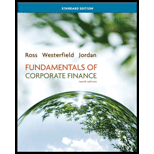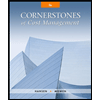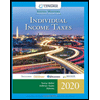
Fundamentals of Corporate Finance Standard Edition
10th Edition
ISBN: 9780078034633
Author: Stephen Ross, Randolph Westerfield, Bradford D. Jordan
Publisher: MCGRAW-HILL HIGHER EDUCATION
expand_more
expand_more
format_list_bulleted
Question
Chapter 12, Problem 6M
Summary Introduction
Case summary:
Company S hired Person X. Person X accepted the job because he felt that the company had a good potential growth. At the end of the first day, Person C met Person X and introduced him to the 401(k) plan. It is a retirement plan that the companies offer to their employees.
The employee has to contribute money from his pre-tax income to the 401(k) plan. The company would also contribute a maximum of 5 percent of the salary to the plan. The plan has the following options for investments:
- 1. Investment in company stock
- 2. Investment in B “S and P” 500 index fund
- 3. Investment in B small-cap fund
- 4. Investment in B large-company stocks fund
- 5. Investment in B Bond fund
- 6. Investment in B
money market fund
Characters in the case:
- Company S: The recruiter
- Person X: The new employee
- Person C: The employee of Company S working in Finance section of the company
To determine: The portfolio allocation chosen by Person X.
Introduction:
Mutual fund refers to the investment in a group or portfolio of assets.
Expert Solution & Answer
Want to see the full answer?
Check out a sample textbook solution
Students have asked these similar questions
Question:
A company has issued a bond with a face value of $1,000, a coupon rate of 5%, and a maturity of 10 years. If the bond is currently trading at $950, what is the bondholder's yield to maturity (YTM), and how does it differ from the coupon rate? need help!!
A company has issued a bond with a face value of $1,000, a coupon rate of 5%, and a maturity of 10 years. If the bond is currently trading at $950, what is the bondholder's yield to maturity (YTM), and how does it differ from the coupon rate?
What is the time value of money, and why is it important in financial decision-making? Need help!
Chapter 12 Solutions
Fundamentals of Corporate Finance Standard Edition
Ch. 12.1 - Prob. 12.1ACQCh. 12.1 - Why are unrealized capital gains or losses...Ch. 12.1 - What is the difference between a dollar return and...Ch. 12.2 - Prob. 12.2ACQCh. 12.2 - Why doesnt everyone just buy small stocks as...Ch. 12.2 - Prob. 12.2CCQCh. 12.2 - About how many times did large-company stocks...Ch. 12.2 - What was the longest winning streak (years without...Ch. 12.2 - How often did the T-bill portfolio have a negative...Ch. 12.3 - Prob. 12.3ACQ
Ch. 12.3 - What was the real (as opposed to nominal) risk...Ch. 12.3 - Prob. 12.3CCQCh. 12.3 - What is the first lesson from capital market...Ch. 12.4 - In words, how do we calculate a variance? A...Ch. 12.4 - With a normal distribution, what is the...Ch. 12.4 - Prob. 12.4CCQCh. 12.4 - What is the second lesson from capital market...Ch. 12.5 - Prob. 12.5ACQCh. 12.5 - Prob. 12.5BCQCh. 12.6 - What is an efficient market?Ch. 12.6 - Prob. 12.6BCQCh. 12 - Chase Bank pays an annual dividend of 1.05 per...Ch. 12 - Prob. 12.2CTFCh. 12 - The risk premium is computed as the excess return...Ch. 12 - Prob. 12.4CTFCh. 12 - Prob. 12.5CTFCh. 12 - Prob. 12.6CTFCh. 12 - Prob. 1CRCTCh. 12 - Prob. 2CRCTCh. 12 - Risk and Return [LO2, 3] We have seen that over...Ch. 12 - Market Efficiency Implications [LO4] Explain why a...Ch. 12 - Efficient Markets Hypothesis [LO4] A stock market...Ch. 12 - Semistrong Efficiency [LO4] If a market is...Ch. 12 - Efficient Markets Hypothesis [LO4] What are the...Ch. 12 - Stocks versus Gambling [LO4] Critically evaluate...Ch. 12 - Efficient Markets Hypothesis [LO4] Several...Ch. 12 - Efficient Markets Hypothesis [LO4] For each of the...Ch. 12 - Prob. 1QPCh. 12 - Prob. 2QPCh. 12 - Prob. 3QPCh. 12 - Prob. 4QPCh. 12 - Prob. 5QPCh. 12 - Prob. 6QPCh. 12 - Prob. 7QPCh. 12 - Prob. 8QPCh. 12 - Prob. 9QPCh. 12 - Prob. 10QPCh. 12 - Prob. 11QPCh. 12 - Prob. 12QPCh. 12 - Prob. 13QPCh. 12 - Prob. 14QPCh. 12 - Prob. 15QPCh. 12 - Prob. 16QPCh. 12 - Prob. 17QPCh. 12 - Prob. 18QPCh. 12 - Prob. 19QPCh. 12 - Prob. 20QPCh. 12 - Prob. 21QPCh. 12 - Prob. 22QPCh. 12 - Prob. 23QPCh. 12 - Prob. 24QPCh. 12 - Prob. 1MCh. 12 - Prob. 2MCh. 12 - Prob. 3MCh. 12 - Prob. 4MCh. 12 - A measure of risk-adjusted performance that is...Ch. 12 - Prob. 6M
Knowledge Booster
Similar questions
- What is the time value of money, and why is it important in financial decision-making?arrow_forwardPlease don't use chatgpt. The formula for calculating the present value of a future amount is:A) Future Value × (1 + r)^nB) Future Value ÷ (1 + r)^nC) Future Value × (1 - r)^nD) Future Value ÷ (1 - r)^n help in this question.arrow_forwardThe formula for calculating the present value of a future amount is:A) Future Value × (1 + r)^nB) Future Value ÷ (1 + r)^nC) Future Value × (1 - r)^nD) Future Value ÷ (1 - r)^n need help!arrow_forward
- no ai What is the primary purpose of diversification in investing?A) To maximize returnsB) To eliminate all riskC) To reduce unsystematic riskD) To ensure stable dividendsarrow_forwardno chatgpt Which of the following is a capital structure decision?A) Deciding how much to pay in dividendsB) Deciding how to allocate funds to various projectsC) Deciding the mix of debt and equity financingD) Deciding how much inventory to purchase need help!arrow_forwardWhich of the following is a capital structure decision?A) Deciding how much to pay in dividendsB) Deciding how to allocate funds to various projectsC) Deciding the mix of debt and equity financingD) Deciding how much inventory to purchasearrow_forward
- No chatgpt!! The weighted average cost of capital (WACC) is used to:A) Measure the profitability of a companyB) Determine the cost of debt financing onlyC) Calculate the company’s average cost of financing from debt and equityD) Estimate the future stock price need help.arrow_forwardNo AI The weighted average cost of capital (WACC) is used to:A) Measure the profitability of a companyB) Determine the cost of debt financing onlyC) Calculate the company’s average cost of financing from debt and equityD) Estimate the future stock pricearrow_forwardCost of Trade Credit A large retailer obtains merchandise under the credit terms of 3/20, net 35, but routinely takes 65 days to pay its bills. (Because the retailer is an important customer, suppliers allow the firm to stretch its credit terms.) What is the retailer's effective cost of trade credit? Assume a 365-day year. Do not round intermediate calculations. Round your answer to two decimal places. The answer is not 27.09 which is incorrect.arrow_forward
- You invest $1,000 a year for 10 years at 6 percent and then invest $2,000 a year for an additional 10 years at 6 percent. How much will you have accumulated at the end of the 20 years? Answer: $49,967 *Please include all work & formulasarrow_forwardNo ai please! What is the role of an underwriter in an IPO?A) To lend money to the companyB) To set the dividend policyC) To buy the securities and sell them to the publicD) To manage the company’s operations need hearrow_forwardNo ai tool What is the role of an underwriter in an IPO?A) To lend money to the companyB) To set the dividend policyC) To buy the securities and sell them to the publicD) To manage the company’s operationsarrow_forward
arrow_back_ios
SEE MORE QUESTIONS
arrow_forward_ios
Recommended textbooks for you
 Cornerstones of Cost Management (Cornerstones Ser...AccountingISBN:9781305970663Author:Don R. Hansen, Maryanne M. MowenPublisher:Cengage Learning
Cornerstones of Cost Management (Cornerstones Ser...AccountingISBN:9781305970663Author:Don R. Hansen, Maryanne M. MowenPublisher:Cengage Learning Individual Income TaxesAccountingISBN:9780357109731Author:HoffmanPublisher:CENGAGE LEARNING - CONSIGNMENT
Individual Income TaxesAccountingISBN:9780357109731Author:HoffmanPublisher:CENGAGE LEARNING - CONSIGNMENT

Cornerstones of Cost Management (Cornerstones Ser...
Accounting
ISBN:9781305970663
Author:Don R. Hansen, Maryanne M. Mowen
Publisher:Cengage Learning


Individual Income Taxes
Accounting
ISBN:9780357109731
Author:Hoffman
Publisher:CENGAGE LEARNING - CONSIGNMENT

